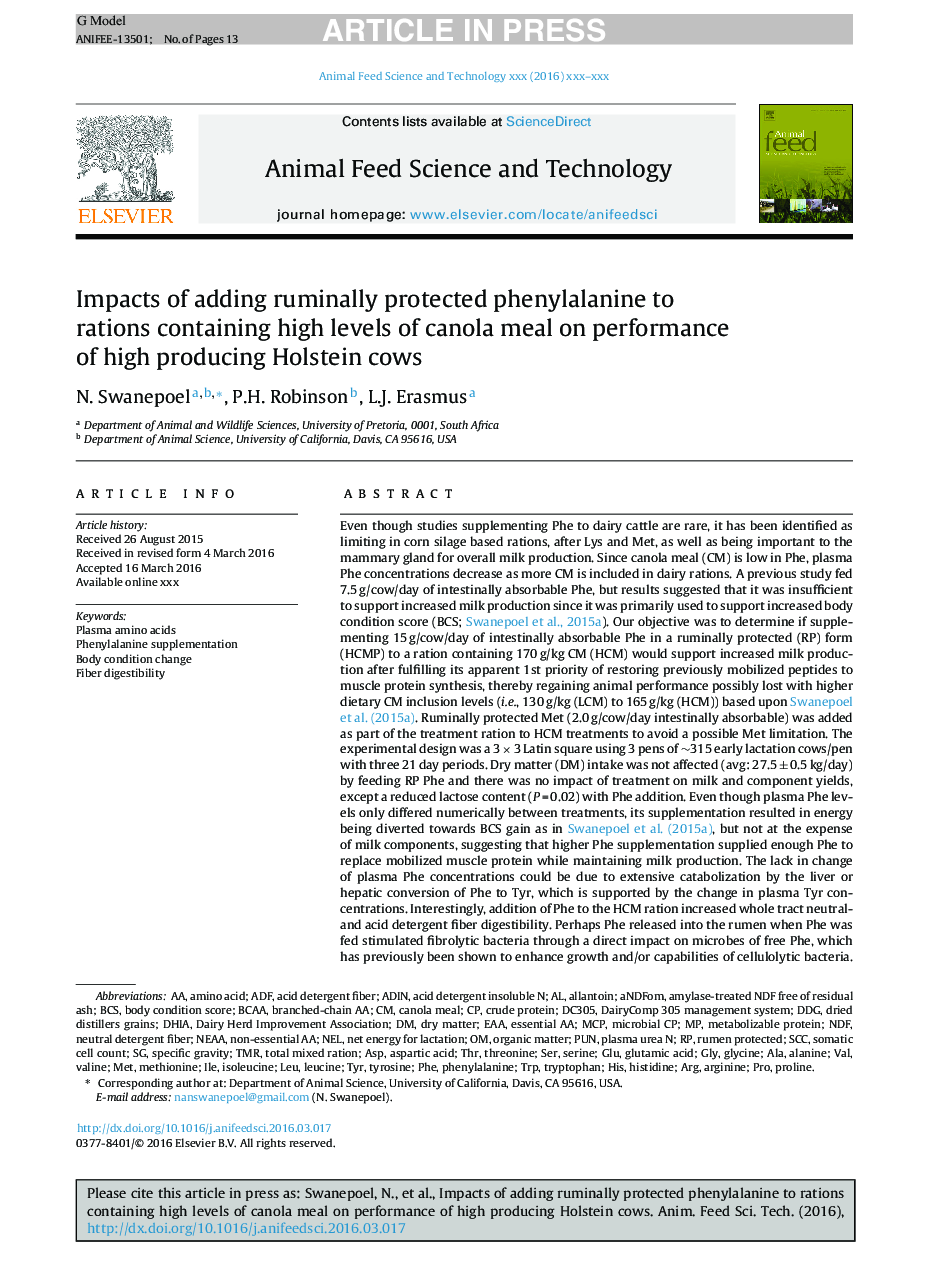| کد مقاله | کد نشریه | سال انتشار | مقاله انگلیسی | نسخه تمام متن |
|---|---|---|---|---|
| 8491238 | 1552369 | 2016 | 13 صفحه PDF | دانلود رایگان |
عنوان انگلیسی مقاله ISI
Impacts of adding ruminally protected phenylalanine to rations containing high levels of canola meal on performance of high producing Holstein cows
دانلود مقاله + سفارش ترجمه
دانلود مقاله ISI انگلیسی
رایگان برای ایرانیان
کلمات کلیدی
SCCPHEASPALATMRLEUDairy Herd Improvement AssociationTrpRumen protectedEAAMCPTHRmicrobial CPNEAANDFDDGADFaNDFomADIN - آدینArginine - آرژنین Aspartic acid - آسپارتیک اسدalanine - آلانینAllantoin - آلتوئینamino acid - آمینو اسیدArg - ارگPlasma amino acids - اسید آمینه پلاسماglutamic acid - اسید گلوتامیکacid detergent fiber - الیاف پاک کننده اسیدnet energy for lactation - انرژی خالص برای شیردهیplasma urea N - اوره پلاسما Nisoleucine - ایولولینIle - باSER - برای بودنBCAA - بی سی ای ایthreonine - ترئونینTryptophan - تریپتوفانSomatic cell count - تعداد سلول های سوماتیکTyr - تیرTyrosine - تیروزینHIS - خودDried distillers grains - دانه های خشک شده خشک شدهNEL - درBCs - روند BCsbranched-chain AA - زنجیره ای AAval - ساعتSerine - سرینessential AA - ضروری AACanola meal - غذای کانولاPhenylalanine - فنیلآلانینneutral detergent fiber - فیبر مواد شوینده خنثیLeucine - لوسینorganic matter - ماده آلیdry matter - ماده خشکMethionine - متیونینMET - ملاقات کردacid detergent insoluble N - مواد شوینده اسیدی N نامحلول استPRO - نرم افزارBody condition score - نمره وضعیت بدنFiber digestibility - هضم فیبرPun - همچنینhistidine - هیستیدینValine - والینSpecific gravity - وزن مخصوصcrude protein - پروتئین خامmetabolizable protein - پروتئین متابولیزه کنندهProline - پرولینtotal mixed ration - کل جیره مخلوط شدهGlu - گلوGly - گلیGlycine - گلیسین
موضوعات مرتبط
علوم زیستی و بیوفناوری
علوم کشاورزی و بیولوژیک
علوم دامی و جانورشناسی
پیش نمایش صفحه اول مقاله

چکیده انگلیسی
Even though studies supplementing Phe to dairy cattle are rare, it has been identified as limiting in corn silage based rations, after Lys and Met, as well as being important to the mammary gland for overall milk production. Since canola meal (CM) is low in Phe, plasma Phe concentrations decrease as more CM is included in dairy rations. A previous study fed 7.5 g/cow/day of intestinally absorbable Phe, but results suggested that it was insufficient to support increased milk production since it was primarily used to support increased body condition score (BCS; Swanepoel et al., 2015a). Our objective was to determine if supplementing 15 g/cow/day of intestinally absorbable Phe in a ruminally protected (RP) form (HCMP) to a ration containing 170 g/kg CM (HCM) would support increased milk production after fulfilling its apparent 1st priority of restoring previously mobilized peptides to muscle protein synthesis, thereby regaining animal performance possibly lost with higher dietary CM inclusion levels (i.e., 130 g/kg (LCM) to 165 g/kg (HCM)) based upon Swanepoel et al. (2015a). Ruminally protected Met (2.0 g/cow/day intestinally absorbable) was added as part of the treatment ration to HCM treatments to avoid a possible Met limitation. The experimental design was a 3 Ã 3 Latin square using 3 pens of â¼315 early lactation cows/pen with three 21 day periods. Dry matter (DM) intake was not affected (avg: 27.5 ± 0.5 kg/day) by feeding RP Phe and there was no impact of treatment on milk and component yields, except a reduced lactose content (P = 0.02) with Phe addition. Even though plasma Phe levels only differed numerically between treatments, its supplementation resulted in energy being diverted towards BCS gain as in Swanepoel et al. (2015a), but not at the expense of milk components, suggesting that higher Phe supplementation supplied enough Phe to replace mobilized muscle protein while maintaining milk production. The lack in change of plasma Phe concentrations could be due to extensive catabolization by the liver or hepatic conversion of Phe to Tyr, which is supported by the change in plasma Tyr concentrations. Interestingly, addition of Phe to the HCM ration increased whole tract neutral- and acid detergent fiber digestibility. Perhaps Phe released into the rumen when Phe was fed stimulated fibrolytic bacteria through a direct impact on microbes of free Phe, which has previously been shown to enhance growth and/or capabilities of cellulolytic bacteria. Total net energy output decreased with HCM feeding, but was restored to the level of the LCM ration for the HCMP treatment suggesting that further investigation to determine if an even higher Phe supplementation level may have additional benefits on milk production may have merit.
ناشر
Database: Elsevier - ScienceDirect (ساینس دایرکت)
Journal: Animal Feed Science and Technology - Volume 216, June 2016, Pages 108-120
Journal: Animal Feed Science and Technology - Volume 216, June 2016, Pages 108-120
نویسندگان
N. Swanepoel, P.H. Robinson, L.J. Erasmus,